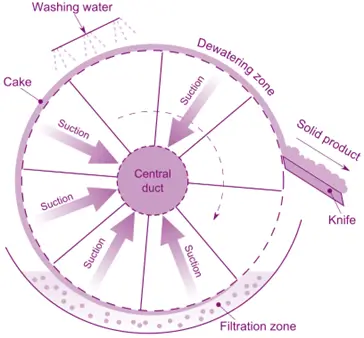Principle of Rotary Drum Filter
- The rotary drum filter operates on the principle of vacuum filtration, where a vacuum is applied inside the drum to draw liquid through the filter medium, leaving solids behind.
Construction of Rotary Drum Filter

Advertisements
- Rotary Drum: A rotating cylindrical drum covered with a filter cloth.
- Vacuum System: Creates a vacuum inside the drum.
- Slurry Tank: Contains the slurry to be filtered.
- Discharge System: For collecting filtrate and removing filter cake.
- Agitator: Keeps the slurry in suspension.
Working
- The drum rotates partially submerged in the slurry tank.
- A vacuum is applied inside the drum, drawing liquid through the filter cloth.
- Solids are retained on the outside of the drum, forming a filter cake.
- As the drum rotates, the filter cake is dried by air or other means.
- The cake is removed by a scraper or other mechanical means.
- The filtrate is collected and drained off.
Advertisements
Uses
- Mineral processing
- Food industry (e.g., sugar refining)
- Wastewater treatment
- Pharmaceutical industry
Merits
- Continuous operation.
- Suitable for large-scale filtration.
- Produces a relatively dry filter cake.
Advertisements
Demerits
- High initial cost.
- Requires significant space.
- Not suitable for very fine particles.
- Maintenance can be complex.

